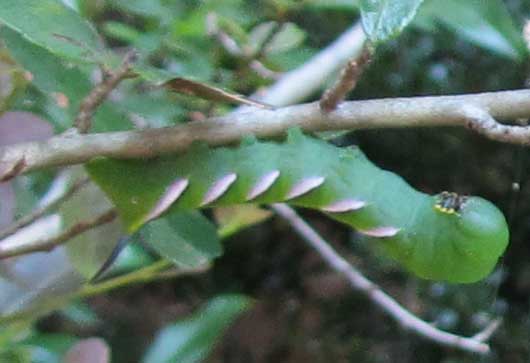
Dolba hyloeus on Yaupon, Wake County, North Carolina,
August 17, 2012, courtesy of Annie Runyon.
|
|
Created/dedicated as per personal communication with Annie Runyon, Dolba hyloeus on Yaupon, August 17, 2012 Updated as per James P. Tuttle's The Hawk Moths of North America, August 17, 2012 Updated as per BAMONA, August 17, 2012 |

Dolba hyloeus on Yaupon, Wake County, North Carolina,
August 17, 2012, courtesy of Annie Runyon.
This page is inspired by and dedicated to Annie Runyon who sends the image of a Dolba hyloeus
caterpillar devouring the Yaupon (Ilex vomitoria) foliage in her yard in Wake County,
August 17, 2012.
Annie writes, "On August 17, 2012, I photographed (not very well, sorry) this caterpillar eating yaupon leaves in my yard in Wake County, NC.
(Yaupon is plant from yard on Ocracoke Island, Hyde County, NC. I am growing it here for tea.)
"Ed Corey suggests it is a Dolba hyloeus and so I ended up reading about them on your fine website. I noticed no one has reported them eating yaupon,
so I thought you might be interested. Unfortunately, all that remains of the cat today is black blood on leaves below where it rested overnight. But now that
I have seen one, Iíll look for more ... and in my pawpaws as well."
I reply: "Hi Annie,
"Ilex vomitoria is a close relative to many of the other Ilex species known as hosts, so it is not such a big surprise. Yes, it is
Dolba hyloeus, and I would like to post an image, credited to you, to a Wake County thumbnail checklist page I will create?"
For care of "found larvae/caterpillars" visit Manduca sexta larva, central Texas, August 21, 2008, Trina Woodall.
Thirty-six Sphingidae species are listed for North Carolina on the BAMONA website. Not all of the species are reported or anticipated in Wake County (Twenty-seven species are reported on BAMONA as of August 17, 2012). It is hoped that this checklist, with the thumbnails and notes, will help you quickly identify the caterpillars (larvae) you are likely to encounter.
A "WO" after the species name indicates that I have no confirmed reports of this species in Wake County, but I (William Oehlke) expect that this moth is present or might be present.
A "BAMONA" indicates the moth is reported on the BAMONA website and/or in Lepidoptera of North America, #1. Distribution of Silkmoths (Saturniidae) and Hawkmoths (Sphingidae) of Eastern North America, an excellent little booklet available through Paul Opler.
Please help me develop this list with improved, documented accuracy by sending sightings (species, date, location), preferably with an electronic image, via email to Bill Oehlke.
Please also forward your sightings to BAMONA, an excellent on-line resource.
Sphinginae subfamily
Smerinthini Tribe:
Macroglossinae subfamilyDilophonotini tribe:
See Hemaris comparison to help distinguish the next three species.
Philampelini tribe:
Macroglossini tribe:
|
Enjoy some of nature's wonderments, giant silk moth cocoons. These cocoons are for sale winter and fall. Beautiful Saturniidae moths will emerge the following spring and summer. Read Actias luna rearing article. Additional online help available.
Eggs of many North American species are offered during the spring and summer. Occasionally summer Actias luna and summer Antheraea polyphemus cocoons are available. Shipping to US destinations is done from with in the US.
Use your browser "Back" button to return to the previous page.
This page is brought to you by Bill Oehlke and the WLSS. Pages are on space rented from Bizland. If you would like to become a "Patron of the Sphingidae Site", contact Bill.
Please send sightings/images to Bill. I will do my best to respond to requests for identification help.
 Show appreciation for this site by clicking on flashing butterfly to the left. The link will take you to a page with links to many insect sites. |
 Show appreciation for this site by clicking on flashing butterfly to the left. The link will take you to a page with links to many insect sites. |
I very much appreciate all the many images that have been sent to me, or of which I have been granted permission to copy and post from other websites. All images on this site remain the property of respective photographers.
If you would like to contribute to the maintenace of this website by sending a contribution to
Bill Oehlke
Box 476
155 Peardon Road
Montague, Prince Edward Island, C0A1R0
Canada
your donation would be much appreciated and would be used for
1) paying for webspace rental;
2) paying for computer maintenance and software upgrades;
3) purchases of additional text reference material (journals and books) in anticipation of expanding the site to a worldwide Sphingidae site;
4) helping to pay my daughter's tuition; with anything left over going to humanitarian aid.
If you are mailing a check from USA, please use $0.85 postage. Donations can also be made through Paypal via the button below.